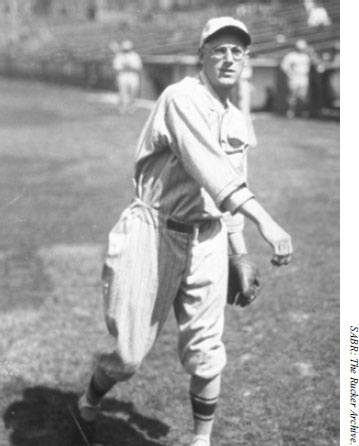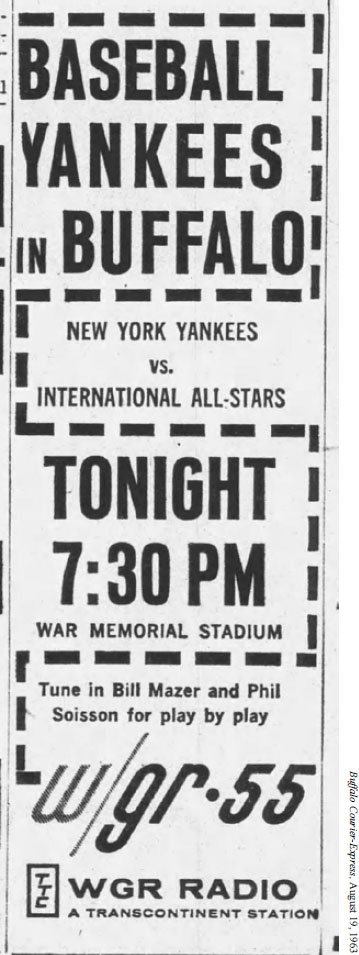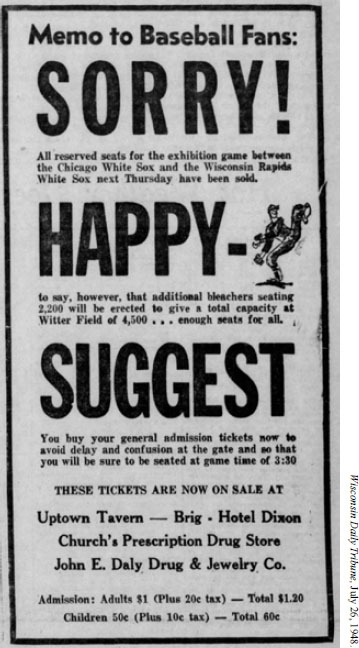Back to the Farm: In-Season Minor-Major League Exhibition Games
This article was written by Kurt Blumenau
This article was published in When Minor League Baseball Almost Went Bust: 1946-1963
Advertisement for August 19, 1963 exhibition game featuring the New York Yankees against the International League All-Stars at Buffalo ’s War Memorial Stadium. (Buffalo Courier-Express, August 19, 1963)
Fans in Montreal and Toronto watched major-league baseball teams years before the Expos or Blue Jays came to town. Same thing with Milwaukee and the Braves or Brewers. For that matter, fans in relatively obscure outposts like Cranston, Rhode Island; Gloversville, New York; and Wisconsin Rapids, Wisconsin, also got to see big leaguers take the field between 1946 and 1963.
The institution that made it happen was the in-season exhibition game. In the twenty-first century, these games are as extinct as the emery ball. But in decades past, major-league teams used offdays during the regular season to play minor-league teams, college teams, and even semipro and company-sponsored outfits. This article will focus exclusively on matchups between major-and minor-league teams—although the faceoffs between the St. Louis Browns and the Belleville Kiwanis, or the Pittsburgh Pirates and the Waterbury Brasscos, are worth exploring in some other setting.1
In-season exhibitions were played long before 1946—researchers have identified them as far back as 1871—and they continued long after 1963. Still, they merit discussion in a minor-league history of these years. They were a familiar aspect of the baseball calendar and a distinctive experience for fans outside major-league cities. Despite their noncompetitive nature, they were also, from time to time, the settings for interesting or noteworthy gameplay.
BY THE NUMBERS
Between 1946 and 1963, major-and minor-league teams faced off during the major-league season roughly 228 times, for an average of about 13 times per season.2 The majority of these games involved a single minor-league team—the Albany (New York) Senators, the Denver Bears, the Toronto Maple Leafs—though it also became common later in the period for big-league teams to face minor-league all-star squads.
Research led by SABR’s Walter LeConte, which identified 5,000 in-season exhibition games of all types from 1871 to 2012, found that the International League accounted for 467 of them—about 9 percent of the total,3 more than any other minor league. Since the IL traditionally operated at the highest level of the minors,4 this confirms that big-league teams were most likely to face off against their top minor-league affiliate. The Eastern League, which most frequently operated at the second-highest level of the minors,5 ranks second on LeConte’s list with 314 in-season exhibitions.
Did the minor leaguers—in theory, the inferior team in every matchup—ever win? A scan through the list of games indicates that the minor leaguers won about 70 games in this period, or about 30 percent of the time.
Of course, the big leaguers didn’t always play at 100 percent intensity, since no one wanted to get hurt in a game that didn’t count. It happened from time to time anyway. Milwaukee Braves catcher Paul Burris suffered a broken and dislocated elbow in a home-plate collision during a June 22, 1953, exhibition game against the Eau Claire (Wisconsin) Bears of the Class-C Northern League. Burris, who had last played a regular-season game on June 4, never appeared again in the big leagues, although he continued to play in the minors through the 1956 season.6
It was also typical for major-league managers to remove their starters after a few innings, sometimes with bitter results. In July 1948, disappointed Montreal Royals fans booed and threw seat cushions when the parent Brooklyn Dodgers pulled local hero Jackie Robinson out of the game after his first-inning at-bat.7 Robinson had been a Montreal fan favorite two seasons earlier, when he hit .349 for the pennant-and playoff-winning Royals of the Triple-A International League en route to integrating the White major leagues.
Major-league managers often used the games as warm-ups for players coming off injury, and as informal tryouts for minor-league players. To cite one example: On June 27, 1955, Baltimore Orioles manager Paul Richards started the injured Joe Coleman against the York (Pennsylvania) White Roses of the Class-B Piedmont League. When Coleman was ineffective, Richards replaced him with Jack Moreland, a semi-pro player on tryout, and then with Dick Fitzgerald, a barely 20-year-old rookie formerly of Lafayette College in Pennsylvania. The White Roses stomped their parent club 13-1.8
Moreland got his picture in a local newspaper, wearing an Orioles uniform and talking to Richards on the bench, but that seems to have been the highlight of his career. A search of Baseball-Reference in December 2022 found no record that he ever played in a regular-season professional game. Fitzgerald pitched in six pro seasons, including three at Triple A, but never reached the majors.
Even if the big-leaguers were easing up on the throttle, the occasional minor-league victory provided a thrill and a source of pride to fans in those communities. The language used by a sportswriter in Scranton, Pennsylvania, in 1948 captures the sentiment: “The Scranton Miners turned giant killers at the Stadium last night where they defeated the Boston Red Sox, 2-1, before a near record attendance of 12,165. … Nine Boston scribes accompanied the team here and were mighty impressed with the local setup.”9
Fourteen seasons later, a sportswriter in Williamsport, Pennsylvania, sounded the same tone after the local Grays beat the Philadelphia Phillies: “The superb five-hit pitching of Ray Culp, Richie Allen’s three-run homer and the 12 hits the Grays collected off three Philadelphia pitchers presented Eastern League class at its best against the big leaguers last night at Bowman Field.”10
Wisconsin Rapids advertisement. (Wisconsin Daily Tribune, July 26, 1948)
THE WHYS AND WHENS
Major-league teams played in-season exhibitions for a number of reasons. Some have faded as the sport has changed, while others remain familiar today.
Big-league schedules included open days—often, but not always, on Mondays—that could be used for exhibitions.11 The All-Star break also offered an opportunity to squeeze in an exhibition or two, though the top star or stars from the major-league team might be absent. On July 10, 1951, while Philadelphia Phillies outfielder Richie Ashburn was making a dazzling catch at the All-Star Game at Detroit’s Briggs Stadium, his Phillies teammates were in Schenectady, New York, dropping a 2-1 decision to the Schenectady Blue Jays, their affiliate in the Class-A Eastern League.12
Unless rain kept the attendance down, exhibitions in minor-league towns served as major money-makers for the home team, often drawing the largest crowds of the season. Sometimes they were the largest in local history, as on July 9, 1951, when a city-record crowd of 10,077 in Ottawa, Ontario, watched the eventual NL champion New York Giants lose 4-1 to their Ottawa farmhands.13 Willie Mays and the Giants drew a crowd of 21,832 five years later to brand-new Metropolitan Stadium in Bloomington, Minnesota; the Giants’ game against the Minneapolis Millers was, at the time, the largest baseball crowd in the history of the Upper Midwest.14
Rochester (New York) Community Baseball, the community ownership group of the Triple-A Red Wings, might have lost money in 1959 if not for an exhibition with the parent St. Louis Cardinals. According to the local newspaper, the Red Wings cleared more than $4,000 from the exhibition while posting a year-end profit of $3,935.15 The May 4 game drew 7,850 fans, and gate receipts were split evenly between the teams, with the Cardinals paying all their own expenses.16
The division of gate receipts mentioned above confirms that big-league teams benefited from exhibitions as well, collecting money from what otherwise would have been open dates. Another example: The New York Yankees collected $17,040 from a net gate of $42,601 in August 1963, when a local record crowd of 28,524 at Buffalo, New York’s War Memorial Stadium watched the IL All-Stars shut out the Yanks on two hits, 5-0.17
Big-league players, in contrast, are not known to have gained financially from in-season exhibitions on a regular basis. Players’ contracts typically required them to appear in games at the club’s discretion from Opening Day until the season’s end, in exchange for regular salary payments. Players received side benefits from in-season exhibitions—such as being wined and dined at banquets or receiving gifts, like the pair of pants and electric razor given to Washington Senators pitcher Dick Welteroth when he returned to Bridgeport, Connecticut, for a 1948 exhibition.18 But there’s no indication that they regularly received extra money for playing.19
(Exceptions existed. Connie Mack reportedly divided the Philadelphia A’s share of money from two July 1948 exhibition games among the team’s players. It was a generous act, and was greeted with incredulity by the newspaper that reported it.20)
The games also offered public-relations opportunities for the major-league team. Players mingled with starstruck fans and signed autographs—or risked a public chastising, like the tut-tutting Mickey Mantle and Whitey Ford got from the Binghamton, New York, newspaper in June 1954 after making themselves scarce for signatures. “The Yankees may be world champions but to a lot of young Triple Cities fans they are far from that,” a scribe wrote.21
Sometimes, a pregame home-run-hitting contest gave the big leaguers a chance to flex their muscles in a risk-free setting for the minor-league fans. In June 1950 Scranton fans got to see Ted Williams and former local hero Walt Dropo tee off before the game—though their lighter-hitting teammates Bobby Doerr and Al Zarilla pulled off an upset tie for victory in the home-run derby.22
All the while, managers and front-office officials from the big-league team ingratiated themselves with the locals—thanking the fans for their support and praising the local facilities. Even the New York Giants’ vinegary Leo Durocher was on his best behavior during his team’s visit to Ottawa in 1951. “Yesterday, Durocher was the polished operator, the goodwill ambassador … affable, all smiles, co-operative, dapper,” one scribe in the Canadian capital reported.23
While it might seem surprising, the major-and minor-league teams that played these exhibitions were not always affiliated. As rumors of Milwaukee’s major-league future circulated in the summer of 1952, the minor-league Brewers hosted the Chicago Cubs, St. Louis Browns, Chicago White Sox, and their parent Boston Braves—who made Milwaukee a major-league city for real when they moved there the following season.
Three years earlier, the St. Louis Cardinals’ Interstate League farm team in Allentown, Pennsylvania, hosted the Philadelphia Phillies, giving Allentown fans a chance to watch area native Curt Simmons pitch for the Phillies. That same season, the Montreal Royals hosted the New York Giants, crosstown rivals of their parent Dodgers, and beat them, 4-2.
And in 1947, the unaffiliated Waterbury (Connecticut) Timers of the Class-B Colonial League lured the New York Yankees and Phillies to town, both while traveling to series in Boston. The eventual World Series champion Yankees played in the rain to about 9,000 fans; the Phillies, to fewer than 1,000.24
Some exhibitions were about much more than making money for the home team or scoring public-relations points with local fans. One such game occurred in Rome, New York—population: about 40,000—on July 9, 1946, during that season’s All-Star break.25 Billy Southworth, son of the Boston Braves’ manager of the same name, had starred in the outfield for the Rome Colonels in 1939 before entering the military during World War II. After serving in Europe, the younger Southworth was killed in a plane crash in Flushing, New York, in February 1945. With the elder Southworth in attendance, the Colonels dedicated monuments to his son and two other former players who died in military service. The Braves then defeated the Colonels 15-7.26
Exhibition games have also sometimes raised money for worthy charitable causes. This noble tradition continued on June 26, 1952, when the Cincinnati Reds and the IL’s Buffalo Bisons—a Detroit Tigers farm club—played an exhibition to raise money for former St. Louis Cardinals infielder George “Specs” Toporcer. Toporcer, who had settled not far away in Rochester, was struggling with encroaching blindness; the game raised nearly $13,000 for his medical expenses.27 The Reds happened to be traveling from New York to Chicago that day, in between series with the Giants and Cubs.
As major-league baseball expanded in the early 1960s, the new franchises joined the exhibition parade. The Los Angeles Angels, second Washington Senators, Houston Colt .45s, and New York Mets all played minor-league exhibitions in their earliest years.
The Angels lost their first two ventures into the arena, being dropped 3-0 by the Toronto Maple Leafs in 1961 and 6-5 by a team of Pacific Coast League all-stars in 1962. Similarly, the Colts—in the telling of one Texas newspaper—got “drygulched” by a team of all-stars from the Double-A Texas League in 1963, losing 7-3.28 Outfielder Jim Beauchamp, then a Cardinals farmhand, hit a ninth-inning grand slam off Houston’s Dick Drott to win it. Perhaps not coincidentally, Houston traded for Beauchamp in the subsequent offseason, and he was a Colt in 1964.
Former St. Louis Cardinals player George “Specs” Toporcer was the beneficiary of proceeds to cover his medical expenses, from an exhibition game in Buffalo on June 26, 1952. (SABR-Rucker Archive)
WHAT HAPPENED NEXT?
In-season exhibitions involving major-and minor-league teams remained a part of professional baseball’s fabric after 1963. In fact, they became slightly more frequent for a time. LeConte’s research indicates that 169 exhibition games of this type were played from 1964 through 1974, or more than 15 per season.29
Several factors-some already at work in 1963—combined to bring an end to major-minor exhibitions, as well as other types of in-season exhibitions.
The longer 162-game season adopted in 1962 left fewer open dates on the schedule. Collectivebargaining agreements between players and owners also limited the number of in-season exhibitions to three in 1970, then reduced it to two for most teams in 1977.30 For context, the 1952 St. Louis Browns played five in-season exhibitions against minor-league teams—plus a sixth against a company-sponsored team—while the ‘53 Browns and 1952 Boston Braves each played four. 31
As relationships between major-league players and owners—once lopsided in favor of the latter—became more balanced, the players began to stick up for their preference of days off and rest during the season. And, as teams invested more money in players, they became more wary of injuries, and less willing to trot out their starters in Ottawa or Tacoma for games that didn’t count.
In one incident near the end of the exhibition era, truculent Baltimore Orioles outfielder Albert Belle posted a petition in his locker in 1999, encouraging his teammates to boycott that season’s exhibition game against the Rochester Red Wings.32 The Orioles and Wings played that season for the last time, ending a tradition that began in 1961.
The list of in-season exhibitions compiled by LeConte—which runs through 2013—includes four major-minor games in 2001, three in 2002, and none since. The final major-minor matchup on the list took place in Buffalo on July 1, 2002, when the Indians beat the Bisons 4-3 in seven innings. The game fulfilled the terms of the teams’ then-current player-development contract, which called on the parent club to make a visit to Buffalo. “It was Cleveland’s first visit to Buffalo since 1996 and could be the last for a long time,” one newspaper reported presciently.33
In baseball and life, trends swing back and forth. (Consider the shifts in ballpark design from jewel boxes to symmetrical multi-use stadia, and then back to jewel box-influenced retro facilities.) With that in mind, it seems inadvisable to say firmly that minor-major exhibitions will never make a comeback.
At the time of this writing in 2024, the thrills of these exhibitions seemed particularly remote. A major-league team’s stop in a minor-league city no longer seems like a visit from distant gods, now that the Internet brings game highlights and athletes’ social media posts directly to fans. Also, minor-league teams have diversified their money-making approach, focusing on colorful merchandise and a full calendar of promotions rather than isolated big paydays.
KURT BLUMENAU grew up in the Rochester, New York, area, following the Mets and the Triple-A Rochester Red Wings. After a dozen years as a journalist, he now works in corporate communications in the Boston area. He has a strong interest in the minor leagues, particularly the New York-Penn League, and also enjoys watching college games.
AUTHOR’S NOTE AND ACKNOWLEDGMENTS
The author is massively indebted to Walter LeConte, as well as to other SABR members who assisted him in compiling listings of in-season exhibition games involving major-league teams between 1879 and 2012. These lists, as well as an accompanying article by LeConte, were available as of fall 2022 in the Special Features section of the Retrosheet website.
While the lists are impressive, they might not be definitively complete. In researching this story, the author discovered an in-season minor-major exhibition that was not listed there—namely, the May 4, 1959, matchup between the St. Louis Cardinals and Rochester Red Wings. The author submitted this information to Retrosheet for consideration.
This article was edited by Thomas Rathkamp and fact-checked by George Pawlush.
SOURCES
In addition to the specific sources cited in the Notes, the author used Baseball-Reference and Retrosheet websites for general player, team, and season data. Walter LeConte’s list of in-season exhibition games and accompanying article, mentioned above, was also a primary source.
NOTES
1 The Browns beat the Belleville (Illinois) Kiwanis 6-3 in Belleville on July 10, 1950. It took the Pirates 11 innings to beat the Waterbury (Connecticut) Brasscos 8-5 in Waterbury on July 29, 1946. While Waterbury had fielded a minor-league team called the Brasscos in the 1920s, the team that played the Pirates in 1946 was semipro. “Pirates Defeat Semi-Pros, 8-5,” Pittsburgh Press, July 30, 1946: 20.
2 A note on methodology: The author started with Retrosheet’s list of in-season exhibitions compiled by Walter LeConte and others (see Author’s Note.) The author cut and pasted all the games from 1946 through 1963 into a spreadsheet. He then deleted any games that involved two major-league teams; semipro teams; college teams; military teams; and teams backed by community organizations such as police and Kiwanis. The author also deleted several games in which the local team could not be identified as belonging to a specific league.
3 For clarity, the 5,000 number represents all in-season exhibition games, not just the ones pitting minor-and major-league teams against each other. The IL’s percentage of the total would be even higher if other types of exhibitions were filtered out.
4 Before 1946, Double A was the highest level of the minors; the IL operated at that level from 1912 to 1945. In 1946, the Triple-A level replaced Double A as the highest level of the minors, and the IL became a Triple-A circuit. Walter LeConte, “ISEG Update,” Retrosheet. Posted February 12, 2013; accessed September 23, 2022.
5 The Eastern League operated at Class A from 1919 through 1962, then moved to Double A in 1963.
6 “Milwaukee Takes 13-11 Decision Over Eau Claire,” Eau Claire (Wisconsin) Daily Telegram, June 23, 1953: 9; Jay Hurd, “Paul Burris,” SABR Biography Project, accessed September 23, 2022.
7 Dink Carroll, “17,809 Fans Denounce Dodger Club as Robinson Is Pulled Out of Game,”Montreal Gazette, July 13, 1948: 14. The Dodgers were jointly managed that night by coaches Clyde Sukeforth and Jake Pitler, as manager Leo Durocher was in St. Louis for the All-Star Game.
8 “Orioles Jolted by York Farmhands, 13-1,” York (Pennsylvania) Dispatch, June 28, 1955: 15.
9 Jimmy Calpin, “Miners Beat Red Sox in Ninth, 2-1, Before 12,165 Fans,” Scranton (Pennsylvania) Tribune, June 15, 1948: 17. The Miners were a Red Sox affiliate in the Class-A Eastern League.
10 “Ray Culp’s 5-Hitter Beats Phils, 5-1,” Williamsport (Pennsylvania) Sun-Gazette, August 1, 1962: 9. The Eastern League was a Class-A loop at that time. Culp pitched four seasons with the Phillies and made an All-Star appearance in his rookie year, 1963, placing third in National League Rookie of the Year voting. Allen went on to play parts of nine seasons with the Phillies, in which he made three All-Star appearances and won the 1964 NL Rookie of the Year Award.
11 Of the 228 major-vs.-minor exhibitions listed in LeConte’s spreadsheet, 124—or about 54 percent—took place on Mondays; 34 on Tuesdays; 19 on Wednesdays; 43 on Thursdays; 6 on Fridays; and 2 on Saturdays.
12 Phillies manager Eddie Sawyer was also in Detroit managing the National League team, an honor traditionally given to the manager of the league’s champion team in the preceding season. “Ashburn Leaping into Air to Spear Near-Homer in All-Star Game” (photo and caption), Philadelphia Inquirer, July 11, 1951: 34; Associated Press, “Phillies Lose, 2-1 to Schenectady,” Philadelphia Inquirer, July 11, 1951: 34.
13 Jack Koffman, “Over 10,000 See Ottawa Giants Whip Durocher’s Gang, 4-1,” Ottawa (Ontario) Evening Citizen, July 10, 1951: 14.
14 T.S. Flynn, “June 7, 1956: Willie Mays Homers Twice in Giants’ Exhibition Win at Metropolitan Stadium,” SABR Games Project. Accessed online December 27, 2022.
15 George Beahon, “Wings Report Profit of $3,935 for 1959,” Rochester (New York) Democrat and Chronicle, November 21, 1959: 14.
16 George Beahon, “Cards Rally for 6 Runs in 12th Inning, Trip Wings, 10-4, Before 7,850 Fans,” Rochester Democrat and Chronicle, May 5, 1959: 32.
17 Cy Kritzer, “An Authentic Team of All-Stars Shocks Yankees Before 28,524,” Buffalo Evening News, August 20, 1963: 12.
18 The Senators played the Bridgeport Bees on August 23, 1948. Welteroth, a former Bridgeport player, received $100 from the Bees’ owners and an additional $50 from fans, as well as the pair of pants and electric razor donated by businesses. John Johansen, “Senators Connect for 17 Hits and Trounce Bees 15-5,” Bridgeport (Connecticut) Telegram, August 24, 1948: 12.
19 Postseason barnstorming tours offered players a chance to make extra money from exhibitions outside the regular season, as extensively detailed in SABR member Thomas Barthel’s Baseball Barnstorming and Exhibition Games, 1901-1962: A History of Off-Season Major League Play (Jefferson, North Carolina: McFarland, 2007). However, player contracts strictly dictated the relationship between player and team during the season.
20 Al Cartwright, “A La Carte,” Wilmington (Delaware) Journal, July 14, 1948: 28. Cartwright’s words: “The heat must have Connie Mack. … He cut up the Athletics’ share from the exhibition games here Monday night and in Harrisburg last night among the players.” The Philadelphia Inquirer also reported that Mack shared some proceeds from an August 1948 exhibition in Meriden, Connecticut, with A’s players. That game is not mentioned in this article because the opposition was an independent squad of local players, not a minor-league team. Art Morrow, “Mack Feted with Team at Meriden,” Philadelphia Inquirer, August 17, 1948: 24.
21 Charley Peet, “Some Yanks Were Really Tough (To Get Along With, That Is),” Binghamton (New York) Press, June 29, 1954: 19. The Yankees were in Binghamton to play their Eastern League affiliate, the Binghamton Triplets. The name Triple Cities (and Triplets) refers to the three neighboring communities of Binghamton, Endicott, and Johnson City, New York.
22 Jimmy Calpin, “Red Sox Outslug Scranton Before 9,342 Fans, 9 to 3,” Scranton Tribune, July 13, 1950: 17. Dropo had played for the Scranton team three seasons earlier, earning attention for his raw power.
23 Edward MacCabe, “The Sportspiel,” Ottawa (Ontario) Journal, July 10, 1951: 13.
24 Associated Press, “New London Bows to Stamford in Colonial League,” Meriden (Connecticut) Journal, August 8, 1947: 4; Associated Press, “Phillies Defeat Waterbury, 7 to 2,” Bridgeport (Connecticut) Telegram, September 4, 1947: 16. The Yankees’ strong turnout in Waterbury might have been owed, in part, to a pitching appearance by Spec Shea, a native of the nearby town of Naugatuck.
25 Rome’s population was measured at 34,224 in the 1940 US Census and 41,682 in the 1950 Census. The entire population of Rome could have just about fit into the Braves’ home park of Braves Field, which had a capacity of 37,746 in 1946, according to the Seamheads.com ballpark database, accessed October 23, 2022.
26 Associated Press, “Braves Win, 15-7, at Ceremony for Southworth’s Son,” Boston Globe, July 10, 1946: 11.
27 Cy Kritzer, “Herd May Obtain Kazak, Howell from Cincy Reds,” Buffalo Evening News, June 27, 1952: 35. The Reds won the game, 5-3, behind homers by Ted Kluszewski and Cal Abrams.
28 United Press International, “Texas Leaguers Drygulch Colts in Exhibition,” McAllen (Texas) Valley Evening Monitor, August 2, 1963: 13.
29 To prepare a list of major-minor exhibitions from 1964 through 1974, the author copied games from the LeConte list into a spreadsheet, and again deleted games not involving minor-league teams—such as those involving college or military teams. It should be noted that, while in-season exhibitions against minor-league teams became slightly more common during this period, other types of exhibitions – those against company-sponsored and semipro teams—disappeared from the major-league agenda.
30 Author’s review of 1970, 1976, and 1990-93 collective-bargaining agreements made available through SABR’s Business of Baseball site. Accessed October 28, 2022. The 1976 agreement allowed the president of each league to grant special permission for up to three additional in-season exhibitions; each team was limited to no more than two unless given permission for a third. By the 1990-93 agreement, the number of in-season exhibitions had been reduced still further, to no more than one unless a team was allowed a second by its league president.
31 In addition to their five exhibitions against minor-league teams, the 1952 Browns played against a team in Moraine, Ohio, sponsored by a business called Moraine Products, according to LeConte’s research and contemporary news accounts. Similarly, the ‘53 Browns also played semipro teams in Hartford, Connecticut, and Fort Wayne, Indiana, on top of their four games against minor-league teams. In still another example of a heavy exhibition workload, the 1948 Philadelphia A’s played minor-league teams three times, and also played in-season exhibitions against the Pittsburgh Pirates and Philadelphia Phillies of the National League.
32 Bob Matthews, “Wings Should Ask the Orioles to Leave Belle Behind,” Rochester Democrat and Chronicle, June 24, 1999: 3D.
33 Bob Matthews, “Fans Selecting All-Star Starters a Hit,” Rochester Democrat and Chronicle, July 2, 2002: 2D.
